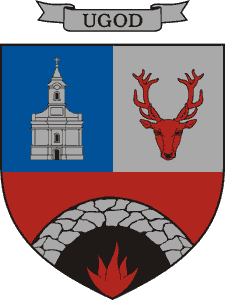Ugod

The castle of Ugod can be found on the northern slopes of the Hungarian Bakony mountain where it meets the Small Hungarian Plain. It was guarding the entrance of the Gerence Stream’s valley. After the home-taking of the Magyar tribes, the area of Ugod belonged to the ruler, and none of the Hungarian Clans settled there as far as the 11th century it remained the king’s land.
This part of the Bakony was controlled by the Comes of Bakony. The village of Ugod received its name after the Comes of Bakony, Ugod, the son of Luka’s son, Demeter of the Csák clan. Ugod (Luka’s grandson) was the one who built its castle after the Mongolian Invasion of 1241 and 1242. They were the Ugod line of the powerful Csák Clan who owned lots of lands in the Bakony Mountains and around it. The place was first mentioned in 1287.

The 13th-century castle had a single tower that was surrounded by octagonal double walls. The stronghold hasn’t had significant reconstructions, except for a few renovations and the addition of the outer castle on the north-western side of the medieval castle. These outer defenses included a 30-meter-wide moat with a trench on the outer side. We have a drawing of Justus van der Nypport that tried to depict Ugod castle, though it never stood on a cliff:

The last member of the Ugodi line of the Csák family was a monk called Móric. He sold the castle to Kőszeghy aka Németújvári Iván. (Note, that I use the Eastern name order for Hungarians where family names come first.) When the Árpád-dynasty was discontinued in 1301, it was King Károly Róbert who broke the power of the feudal lords and took away the lands of the great Kőszeghy and Csák families.
This was how the king gave Ugod castle to a Czech nobleman, Chenig in 1325. Master Chenig also used to be the king’s Captain of Vöröskő ( Hrad Červený Kameň) castle between 1340-49. Chenig became the king’s diplomat and he was traveling to Italy and Avignon on behalf of the king. When he died without leaving an heir in 1380, his lands were returned to the monarch.

King Matthias gave the castles of Ugod, Devecser, Pápa, and Gesztes to Török Ambrus of Enying and his wife, Devecseri Katalin in 1473. Despite this fact, Lord Szapolyai gained these castles during the next year. After the Battle of Mohács, in 1526, King Szapolyai János gave Ugod castle to Matusnai János who had fled there from the Southern parts of Hungary.
Csoron András bought the castle and half of its villages from him in 1532, in exchange for 2,600 gold Forints. He purchased the other part of the dominion (including some villages from Tolna County) in 1539, paying an additional 3,000 Forints. This family had owned it until 1616 when Mrs. Nádasdy Tamás gained it. The Nádasdy family was famous for their valiant deeds against the Ottomans, here is more about them:

Later the place became the property of the Esterházy family. According to the records, there was a garrison in the castle in 1648 but the fort was destroyed in the second part of the 17th century during the Ottoman wars. However, smaller strongholds like Ugod which stood in the second line of the Borderland system of fortifications had a very important role. Despite the two dense lines of smaller and bigger castles, the Turks were able to raid even the furthest corner of the Kingdom of Hungary and could penetrate as far as Bohemia or Austria at times.
Imagine, what would have happened without the Frontier system and without the warriors who defended them, the “knights” of the Valiant Order? You can read more about this 1,000-mile-long structure of fortifications that separated the Ottoman Empire and the rest of Europe roughly between the 1400s and 1699 here:
https://www.hungarianottomanwars.com/essays/the-borderland/
It was Esterházy Ferenc who began to build a new church in the center of the castle at the end of 1753. Assumedly, the moat was filled up by the stones of the old church. After the death of Esterházy Ferenc, it was his son, Esterházy Károly (later Bishop of Eger) who finished the construction in 1759. In our days, we can see the remnants of earthen walls on the western side of the church. The stone walls on the southwestern and the eastwestern side of the castle had been reconstructed by 2014.

You can read a detailed article (in Hungarian) about the history of Ugod castle here:
Dear Readers, I can only make this content available through small donations or by selling my books or T-shirts:
Please, feel free to support me with a coffee here:
You can check out my books on Amazon or Draft2Digital, they are available in hardcover, paperback, or ebook:
https://www.amazon.com/dp/198020490X or at https://books2read.com/b/boYd81

My work can also be followed and supported on Patreon: Become a Patron!http://Become a Patron!

[wpedon id=”9140″]

https://hungarianottomanwars.myspreadshop.com/all


















